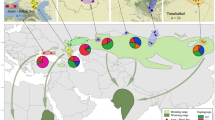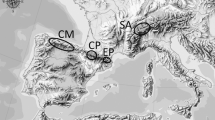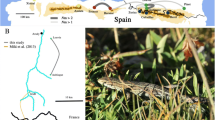Abstract
Resolving the migratory connectivity (identifying non-breeding grounds) of migrating bird populations that are morphologically similar is crucial for an understanding of their population dynamics and ultimately their conservation. Such is the case in Black-tailed Godwits Limosa limosa, where the Iceland-breeding subspecies islandica shows overlap during the non-breeding season with the continental-Europe-breeding limosa. On the basis of variation in the control region of mitochondrial DNA, it was already shown that there is a clear geographic structure in their phylogeography and a clear discrimination between the haplotypes of the two subspecies. We can thus assign subspecies of non-breeding individuals on the basis of a molecular assay. Here we validated this approach using samples of 113 birds with known breeding origin, and on the basis of haplotype variation, all birds were properly assigned to each subspecies. We then tested for overlap during non-breeding season using a sample of 278 birds from an Iberian wintering and staging area, the inland rice fields in southwest Iberia (Extremadura, Spain). We showed that even in this inland area, 6.5 % of the birds belonged to islandica subspecies, thus demonstrating the usefulness of genetic markers as an alternative or supplementary method to the most common approach, individual colour-ringing.
Zusammenfassung
Überschneiden sich verschiedene Unterarten der Uferschnepfe Limosa limosa in den iberischen Winter- und Rastgebieten? Eine Bestätigung anhand genetischer Marker
Die Aufklärung der Zugkonnektivität (Ermittlung der Überwinterungsgebiete) von morphologisch ähnlichen Zugvogelpopulationen ist entscheidend für das Verständnis ihrer Populationsdynamik und somit letzten Endes auch für ihren Schutz. Ein solcher Fall ist die Uferschnepfe Limosa limosa, bei der die in Island brütende Unterart islandica außerhalb der Brutzeit mit der in Kontinentaleuropa brütenden Nominatform limosa zusammentrifft. Anhand der Variation in den Kontrollregionen mitochondrialer DNA konnte bereits gezeigt werden, dass die beiden Unterarten eine klare geografische Struktur in ihrer Phylogeografie und eine deutliche Trennung zwischen den Haplotypen aufweisen. Somit kann man mit molekularen Methoden auch außerhalb der Brutzeit Individuen einer Unterart zuordnen. Hier prüften wir diesen Ansatz anhand einer Stichprobe von 113 Vögeln bekannter Brutherkunft, von denen alle auf der Grundlage der Haplotyp-Variation korrekt der Unterart zugeordnet werden konnten. Anschließend testeten wir mittels einer Stichprobe von 278 Vögeln aus einem iberischen Rast- und Überwinterungsgebiet - den im Inland gelegenen Reisfeldern im Südwesten der Iberischen Halbinsel (Extremadura, Spanien) - auf eine Überlappung außerhalb der Brutzeit. Es zeigte sich, dass selbst in dieser Binnenlandregion 6,5 % der Vögel zur Unterart islandica gehörten, wodurch die Eignung genetischer Marker als alternative oder zusätzliche Methode zur individuellen Farbberingung als dem verbreitetsten Ansatz belegt wird.


Similar content being viewed by others
References
Alves JA, Lourenço PM, Piersma T, Sutherland WJ, Gill JA (2010) Population overlap and habitat segregation in wintering Black-tailed Godwits Limosa limosa. Bird Study 57:381–391
BirdLife International (2010) Species factsheet: Limosa limosa. http://www.birdlife.org
Boulet M, Norris DR (2006) The past and present of migratory connectivity. Ornit Monog 61:1–13
Clement M, Posada D, Crandall K (2000) TCS: a computer program to estimate gene genealogies. Mol Ecol 9(10):1657–1660
Gill JA, Langston RHW, Alves JA, Atkinson PW, Bocher P, Vieira NC, Crockford NJ, Gélinaud G, Groen N, Gunnarsson TG, Hayhow B, Hooijmeijer J, Kentie R, Kleijjn D, Lourenço PM, Masero JA, Meunier F, Potts PM, Roodbergen M, Schekkerman H, Schroder J, Wymenga E, Piersma T (2007) Contrasting trends in two Black-tailed Godwit populations: a review of causes and recommendations. Wader Study Group Bull 114:43–50
Gunnarsson TG, Gill JA, Atkinson PW, Gélinaud G, Potts PM, Croger RE, Gudmundsson GA, Appleton GF, Sutherland WJ (2006a) Population-scale drivers of individual arrival times in migratory birds. J Anim Ecol 75(5):1119–1127
Gunnarsson TG, Gill JA, Goodacre SL, Gelinaud G, Atkinson PW, Hewitt GM, Potts PM, Sutherland WJ (2006b) Sexing of Black-tailed Godwits Limosa limosa islandica: a comparison of behavioural, molecular, biometric and field-based techniques. Bird Study 53:193–198
Höglund J, Johansson T, Beintema A, Schekkerman H (2009) Phylogeography of the Black-tailed Godwit Limosa limosa: substructuring revealed by mtDNA control region sequences. J Ornithol 150(1):45–53
Kirby J, Scott D (2009) Black-tailed Godwit. In: Delany S, Scott D, Dodman T, Stroud D (eds) An atlas on wader populations in Africa and Western Eurasia. Wetlands International and International Wader Study Group, Kuala Lumpur
Lee JC, Tsai LC, Hwa PY, Chan CL, Huang A, Chin SC, Wang LC, Lin JT, Linacre A, Hsieh HM (2010) A novel strategy for avian species and gender identification using the CHD gene. Mol Cell Probes 24(1):27–31
Lopes RJ, Hortas F, Wennerberg L (2008) Geographical segregation in Dunlin Calidris alpina populations wintering along the East Atlantic migratory flyway—evidence from mitochondrial DNA analysis. Divers Distrib 14:732–741
Lourenço PM, Kentie R, Schroeder J, Alves JA, Groen NM, Hooijmeijer J, Piersma T (2010) Phenology, stopover dynamics and population size of migrating Black-tailed Godwits Limosa limosa limosa in Portuguese rice plantations. Ardea 98(1):35–42
Masero JA, Santiago-Quesada F, Sánchez-Guzmán JM, Abad-Goméz JM, Auxiliadora V, Albano N (2009) Geographical origin, return rates, and movements of the near-threatened Black-tailed Godwit Limosa limosa at a major stopover site of Iberia. Ardeola 56(2):253–258
Masero JA, Santiago-Quesada F, Sánchez-Guzmán JM, Auxiliadora V, Abad-Goméz JM, Lopes RJ, Encarnação V, Corbacho C, Morán R (2011) Long lengths of stay, large numbers, and trends of the Black-tailed Godwit Limosa limosa in rice fields during spring migration. Bird Cons Int 21(1):12–24
Perez-Tris J, Telleria JL (2002) Migratory and sedentary blackcaps in sympatric non-breeding grounds: implications for the evolution of avian migration. J Anim Ecol 71:211–224
R Development Core Team (2011) R: A language and environment for statistical computing. R Foundation for Statistical Computing, Vienna
Salomonsen F (1955) The evolutionary significance of bird migration. Biol Meddel 22:1–62
Schroeder J, Lourenco PM, van der Velde M, Hooijmeijer J, Both C, Piersma T (2008) Sexual dimorphism in plumage and size in Black-tailed Godwits Limosa limosa limosa. Ardea 96(1):25–37
Webster MS, Marra PP, Haig SM, Bensch S, Holmes RT (2002) Links between worlds: unraveling migratory connectivity. Trends Ecol Evol 17:76–83
Wink M (2006) Use of DNA markers to study bird migration. J Ornithol 147:234–244
Zar JH (2009) Biostatistical analysis, 5th edn. Prentice Hall, New Jersey
Acknowledgments
The authors thank two anonymous reviewers for their helpful suggestions and comments. This work was supported by funding from FCT (Fundação para a Ciência e Tecnologia) grant SFRH/BPD/40786/2007 (RJ Lopes), Calouste Gulbenkian Foundation (JA Alves), NERC (JA Gill). Several members of the Farlington Ringing Group have participated in many godwit catches throughout the range, thus helping attaining samples used here.
Author information
Authors and Affiliations
Corresponding author
Additional information
Communicated by M. Wink.
Rights and permissions
About this article
Cite this article
Lopes, R.J., Alves, J.A., Gill, J.A. et al. Do different subspecies of Black-tailed Godwit Limosa limosa overlap in Iberian wintering and staging areas? Validation with genetic markers. J Ornithol 154, 35–40 (2013). https://doi.org/10.1007/s10336-012-0865-8
Received:
Revised:
Accepted:
Published:
Issue Date:
DOI: https://doi.org/10.1007/s10336-012-0865-8




